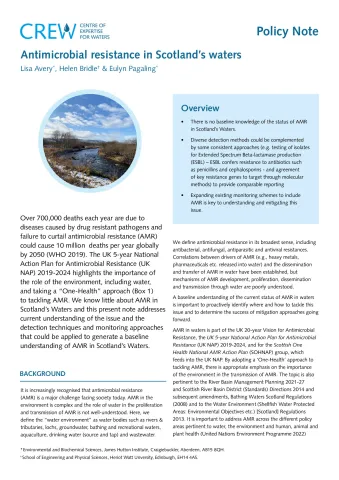This project evaluated the current status of antimicrobial resistance (AMR) in Scotland’s waters and identified emerging monitoring approaches and potential technological solutions. The project involved a literature review and elicitation of expert opinion via the use of a questionnaire survey of academics, industry and regulatory stakeholders, and a follow-up workshop. Findings were synthesised into a policy briefing on “Technologies for monitoring and treatment of antimicrobial resistance in water” and a Policy Note on “Antimicrobial resistance in Scotland’s waters”.
There was no broad baseline understanding of the current AMR status of Scotland’s Waters. It was noted that the most cost-effective mechanism to generate a baseline understanding of AMR in Scotland’s waters was to build on existing sampling regimes and add in further sampling where specific water types weren’t already covered. A key outcome from both literature and expert elicitations was that there is little consistency of methods across studies and monitoring for AMR. There was no consensus on the best detection method, but the most popular were cultivation methods and polymerase chain reaction (PCR)-based methods, which are more easily accessible to researchers. Diversity of approaches is needed for research purposes. However, developing some guidelines to promote complementing these diverse approaches with some consistent ones (such as specified antimicrobial susceptibility testing on isolated E. coli and detection of a specified suite of antimicrobial resistance genes) would help provide comparable reporting and better understanding of AMR in a One-Health context. Additionally, agreement and guidance would support technology developers to improve and validate new approaches – while there is a lot of research on AMR detection methods the majority is clinical rather than environmental.
A Code of Practice would be useful to define different use cases and key measurement parameters along with validation approaches. Treatment technologies can remove AMR and cost-benefit analyses are needed to compare different treatment and mitigation strategies.
| Attachment | Size |
|---|---|
| CREW Policy Note | 255.4 KB |
| CREW Policy Brief | 895.56 KB |
| CREW Policy Brief Appendices | 1.06 MB |
